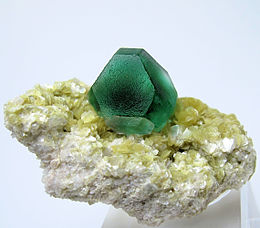
Back Vloeispaat Afrikaans فلوريت Arabic Fluorita AST Flüorit Azerbaijani Флюарыт Byelorussian Флюарыт BE-X-OLD Флуорит Bulgarian ফ্লোরাইট Bengali/Bangla Fluorit Breton Fluorit BS
| Fluorite | |
|---|---|
 Deep green isolated fluorite crystal resembling a truncated octahedron, set upon a micaceous matrix, from Erongo Mountain, Erongo Region, Namibia (overall size: 50 mm × 27 mm, crystal size: 19 mm wide, 30 g) | |
| General | |
| Category | Halide mineral |
| Formula (repeating unit) | CaF2 |
| IMA symbol | Flr[1] |
| Strunz classification | 3.AB.25 |
| Crystal system | Isometric |
| Crystal class | Hexoctahedral (m3m) H–M symbol: (4/m 3 2/m) (cF12) |
| Space group | Fm3m (No. 225) |
| Unit cell | a = 5.4626 Å; Z = 4 |
| Identification | |
| Color | Colorless, although samples are often deeply colored owing to impurities; Purple, lilac, golden-yellow, green, blue, pink, champagne, brown. |
| Crystal habit | Well-formed coarse sized crystals; also nodular, botryoidal, rarely columnar or fibrous; granular, massive |
| Twinning | Common on {111}, interpenetrant, flattened |
| Cleavage | Octahedral, perfect on {111}, parting on {011} |
| Fracture | Subconchoidal to uneven |
| Tenacity | Brittle |
| Mohs scale hardness | 4 (defining mineral) |
| Luster | Vitreous |
| Streak | White |
| Diaphaneity | Transparent to translucent |
| Specific gravity | 3.175–3.184; to 3.56 if high in rare-earth elements |
| Optical properties | Isotropic; weak anomalous anisotropism; moderate relief |
| Refractive index | 1.433–1.448 |
| Fusibility | 3 |
| Solubility | slightly water soluble and in hot hydrochloric acid |
| Other characteristics | May be fluorescent, phosphorescent, thermoluminescent, and/or triboluminescent |
| References | [2][3][4][5] |
Fluorite (also called fluorspar) is the mineral form of calcium fluoride, CaF2. It belongs to the halide minerals. It crystallizes in isometric cubic habit, although octahedral and more complex isometric forms are not uncommon.
The Mohs scale of mineral hardness, based on scratch hardness comparison, defines value 4 as fluorite.[6]
Pure fluorite is colourless and transparent, both in visible and ultraviolet light, but impurities usually make it a colorful mineral and the stone has ornamental and lapidary uses. Industrially, fluorite is used as a flux for smelting, and in the production of certain glasses and enamels. The purest grades of fluorite are a source of fluoride for hydrofluoric acid manufacture, which is the intermediate source of most fluorine-containing fine chemicals. Optically clear transparent fluorite has anomalous partial dispersion, that is, its refractive index varies with the wavelength of light in a manner that differs from that of commonly used glasses, so fluorite is useful in making apochromatic lenses, and particularly valuable in photographic optics. Fluorite optics are also usable in the far-ultraviolet and mid-infrared ranges, where conventional glasses are too opaque for use. Fluorite also has low dispersion, and a high refractive index for its density.
- ^ Warr, L.N. (2021). "IMA–CNMNC approved mineral symbols". Mineralogical Magazine. 85 (3): 291–320. Bibcode:2021MinM...85..291W. doi:10.1180/mgm.2021.43. S2CID 235729616.
- ^ Anthony, John W.; Bideaux, Richard A.; Bladh, Kenneth W.; Nichols, Monte C., eds. (1990). "Fluorite". Handbook of Mineralogy (PDF). Vol. III (Halides, Hydroxides, Oxides). Chantilly, VA, US: Mineralogical Society of America. ISBN 0962209724. Archived (PDF) from the original on 2006-09-06. Retrieved December 5, 2011.
- ^ Cite error: The named reference
Mindatwas invoked but never defined (see the help page). - ^ Fluorite. Webmineral.com
- ^ Hurlbut, Cornelius S.; Klein, Cornelis, 1985, Manual of Mineralogy, pp. 324–325, 20th ed., ISBN 0-471-80580-7
- ^ Tabor, D. (1954). "Mohs's Hardness Scale - A Physical Interpretation". Proc. Phys. Soc. B. 67 (3): 249. Bibcode:1954PPSB...67..249T. doi:10.1088/0370-1301/67/3/310. Retrieved 19 January 2022.